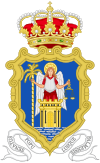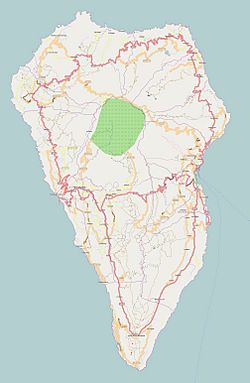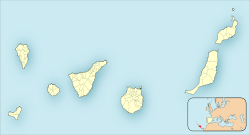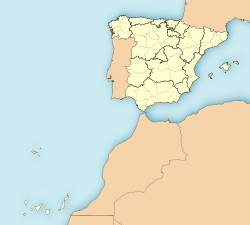Santa Cruz de La Palma facts for kids
Quick facts for kids
Santa Cruz de la Palma
|
|||
|---|---|---|---|
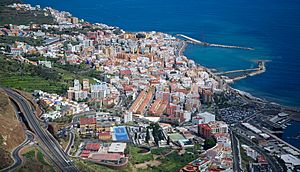
Santa Cruz de La Palma
|
|||
|
|||
| Country | |||
| Autonomous community | |||
| Province | Santa Cruz de Tenerife | ||
| Island | La Palma | ||
| Founded | 3 May 1493 | ||
| Area | |||
| • Total | 43.38 km2 (16.75 sq mi) | ||
| Elevation | 4 m (13 ft) | ||
| Population
(2018)
|
|||
| • Total | 15,674 | ||
| • Density | 361.32/km2 (935.81/sq mi) | ||
| Demonym(s) | Santacrucero,ra | ||
| Time zone | WET | ||
| • Summer (DST) | WEST | ||
| Postal code |
38700
|
||
| Official language(s) | Spanish | ||
Santa Cruz de la Palma is a city and a municipality in Spain. Its name means Holy Cross of La Palma in Spanish. It is located on the east coast of La Palma island. This island is part of the Canary Islands.
Santa Cruz de la Palma is the capital city of La Palma. It is the second-largest city on the island. The city is built on an old lava flow. This lava came from a small volcano called Caldereta. About 13,000 people live in the city itself. The rest of the population lives in other nearby areas.
Contents
History of Santa Cruz de la Palma
City Founding and Early Days
The city was started by Alonso Fernández de Lugo. This happened on May 3, 1493. It was built near a river and a cave. The cave was called Tedote. Today, it is known as Cueva de Carías.
The city was first named Villa del Apurón. It became an important port. Ships sailed from here to the Americas. The city exported goods like sugarcane from the island.
Pirate Attacks and Fortifications
Over time, pirates attacked the city. They would raid and steal from it. After these attacks, the city was rebuilt. Strong walls and forts were added. These were to protect against future pirate attacks.
Two famous forts are the Castillo de Santa Catalina and Castillo de la Virgen. These helped keep the city safe.
Population Changes Over Time
Later, the island's farming economy faced problems. This caused many people to leave the city. The population dropped a lot. It went down to about 11,000 people. For a hundred years, the population stayed low. It did not reach its original size of 18,000 again.
Climate in Santa Cruz de la Palma
Santa Cruz de la Palma has a hot semi-arid climate. This means it is usually warm and dry. Summers are very warm and have almost no rain. This lasts from April to September. Winters are warm too, but they get more rain. This period is from October to March.
| Climate data for La Palma Airport 33m (1981-2010); 8 kilometres (5.0 mi) from the city. | |||||||||||||
|---|---|---|---|---|---|---|---|---|---|---|---|---|---|
| Month | Jan | Feb | Mar | Apr | May | Jun | Jul | Aug | Sep | Oct | Nov | Dec | Year |
| Record high °C (°F) | 27.0 (80.6) |
31.0 (87.8) |
32.8 (91.0) |
36.6 (97.9) |
32.4 (90.3) |
29.4 (84.9) |
38.4 (101.1) |
38.0 (100.4) |
36.8 (98.2) |
34.4 (93.9) |
31.6 (88.9) |
28.0 (82.4) |
38.4 (101.1) |
| Mean daily maximum °C (°F) | 20.6 (69.1) |
20.7 (69.3) |
21.2 (70.2) |
21.6 (70.9) |
22.6 (72.7) |
24.1 (75.4) |
25.5 (77.9) |
26.3 (79.3) |
26.6 (79.9) |
25.5 (77.9) |
23.5 (74.3) |
21.8 (71.2) |
23.3 (74.0) |
| Daily mean °C (°F) | 18.1 (64.6) |
18.0 (64.4) |
18.5 (65.3) |
18.9 (66.0) |
20.0 (68.0) |
21.7 (71.1) |
23.1 (73.6) |
23.9 (75.0) |
24.0 (75.2) |
22.8 (73.0) |
20.9 (69.6) |
19.3 (66.7) |
20.8 (69.4) |
| Mean daily minimum °C (°F) | 15.5 (59.9) |
15.3 (59.5) |
15.7 (60.3) |
16.2 (61.2) |
17.4 (63.3) |
19.2 (66.6) |
20.7 (69.3) |
21.4 (70.5) |
21.3 (70.3) |
20.2 (68.4) |
18.3 (64.9) |
16.7 (62.1) |
18.2 (64.7) |
| Record low °C (°F) | 9.4 (48.9) |
10.9 (51.6) |
10.2 (50.4) |
10.0 (50.0) |
11.0 (51.8) |
15.2 (59.4) |
14.9 (58.8) |
16.7 (62.1) |
16.4 (61.5) |
15.3 (59.5) |
10.0 (50.0) |
10.0 (50.0) |
9.4 (48.9) |
| Average rainfall mm (inches) | 49 (1.9) |
57 (2.2) |
33 (1.3) |
19 (0.7) |
7 (0.3) |
2 (0.1) |
1 (0.0) |
1 (0.0) |
12 (0.5) |
41 (1.6) |
70 (2.8) |
80 (3.1) |
372 (14.5) |
| Average rainy days | 5 | 4 | 4 | 3 | 1 | 0 | 0 | 0 | 2 | 5 | 7 | 8 | 40 |
| Mean monthly sunshine hours | 141 | 146 | 177 | 174 | 192 | 188 | 222 | 209 | 187 | 175 | 140 | 138 | 2,106 |
| Source: Agencia Estatal de Meteorología | |||||||||||||
Tourism and Port Activities
Santa Cruz de la Palma has the main port on the island. This port is very busy. Ferries travel from here to Cádiz in Spain. They also go to other Canary Islands like Tenerife, Gran Canaria, and Lanzarote.
Big ferry companies use this port. These include Naviera Armas, Fred. Olsen Express, and Trasmediterránea. Many cruise ships also visit the port.
In a place called Las Nieves, there is an important church. It is the Real Santuario Insular de las Virgen de las Nieves. This church is dedicated to the patron saint of La Palma island.
Media
- El Apurón: elapuron.com is a local media source.
Sport
Football Rivalry
In Santa Cruz de la Palma, there are two main football teams. They are SD Tenisca and CD Mensajero. Their games are a big rivalry on the island of La Palma. One game in 1983 was known for being very intense.
Historical Population
| Year | Population |
|---|---|
| Late-19th century | around 18,000 |
| 1900 | 11,000 |
| 1991 | 17,205 |
| 1996 | 17,265 |
| 2001 | 17,265 |
| 2002 | 18,228 |
| 2003 | 18,201 |
| 2004 | 17,857 |
| 2008 | 17,132 |
| 2013 | 16,330 |
| 2023 | 15,441 |
People
- Manolo Blahnik, a famous shoemaker.
Images for kids
See also
 In Spanish: Santa Cruz de La Palma para niños
In Spanish: Santa Cruz de La Palma para niños



